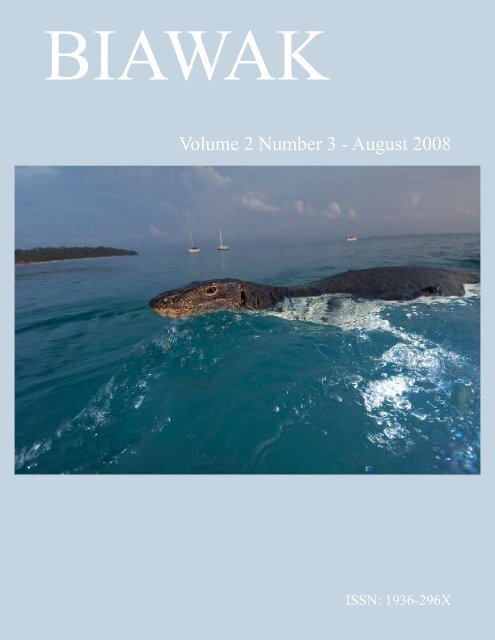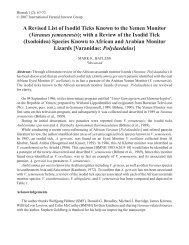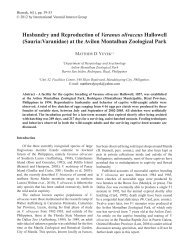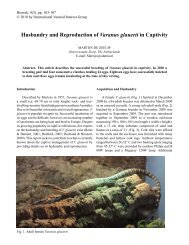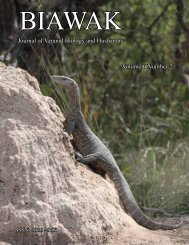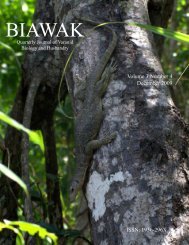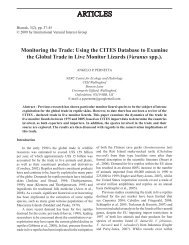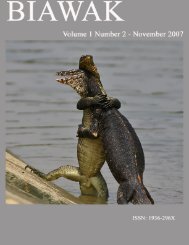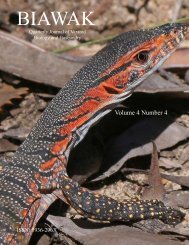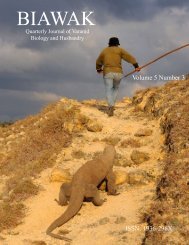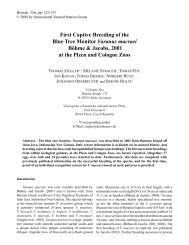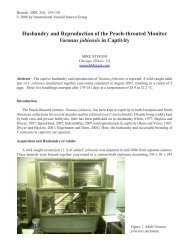Volume 2 Number 3 - International Varanid Interest Group
Volume 2 Number 3 - International Varanid Interest Group
Volume 2 Number 3 - International Varanid Interest Group
You also want an ePaper? Increase the reach of your titles
YUMPU automatically turns print PDFs into web optimized ePapers that Google loves.
107Biawak 2008 Vol. 2 No. 3abundant. Snails, the main food of M. macrocephala, are readily available in the park’s ponds and allowthe turtles to survive. Varanus salvator is another commonly observed aquatic animal in the park.On 29 October 2006, TB and SS observed, at 0725 h, an adult V. salvator (ca. 75 cm SVL) swimmingin an artificial pond. The observed individual left the water to search for food at the base of a bridge withdense vegetation. It was using its head to forage among the plants where it seized a young M. macrocephala(straight carapace length ca. 10 cm). It turned the turtle from its transverse position to a position parallelto the head, widely opened its mouth, and swallowed the whole turtle without biting nor masticating(Figure 1). Immediately after this, it continued to search for more food and found a second, larger, M.macrocephala (straight carapace length ca. 20 cm) at direct proximity. In spite of efforts to correctlyorientate the turtle’s body to swallow it (Figure 2), it was unable to do so and released it, probably due toits too large size. Just following this, it rested and basked at the same place for about ten minutes beforegoing back to swim in the water. The observers did not disturb the monitor during the observations. Forthe next 15 min, TB and SS surveyed 100 m along the water reservoir and encountered four additionalwater monitors (SVL from 60 to 75 cm), resting on the bank or swimming. Another visit by TB and SS on5 November 2006 starting at 0850 h on the same transect allowed the observation of eight individuals ofV. salvator, whose SVL were from 45 to 80 cm. The abundancy of both V. salvator and M. macrocephalain Lumpini Park suggests that this predator-prey relationship is locally common, and that monitors mightplay an important role in locally regulating turtle populations.Acknowledgements - We are grateful to Maren Gaulke, Henrik Bringsøe and Indraneil Das for providinguseful literature and information.Figure 1. Adult Varanus salvator swallowing a young Malayemys macrocephala in Lumpini Park,Bangkok
Biawak 2008 Vol. 2 No. 3 108Figure 2. Adult V. salvator unsuccessfully trying to swallow an adult M. macrocephala in Lumpini Park,BangkokLiterature CitedBrophy, T.R. 2004. Geographic variation and systematics in the South-east Asian turtles of the genusMalayemys (Testudines: Bataguridae). Hamadryad 29(1): 63-79.Gaulke, M. 1991. On the diet of the water monitor, Varanus salvator, in the Philippines. Mertensiella 2:143-153.Karunarathna, D.M.S.S., A.A.T. Amarasinghe and E.M.K.B. Ekanayake. 2008. Observed predation on aSuckermouth catfish (Hypostomus plecostomus) by a Water monitor (Varanus salvator) in Bellanwila-Attidiya Sanctuary. Biawak 2(1): 37-39.Losos, J.B. and H.W. Greene. 1988. Ecological and evolutionary implications of diet in monitor lizards.Biological Journal of the Linnean Society 35: 379-407.Shine, R., Ambariyanto, P.S. Harlow and Mumpuni. 1998. Ecological traits of commercially harvestedwater monitors, Varanus salvator, in northern Sumatra. Wildlife Research 25: 437-447.Traeholt, C. 1994a. The food and feeding behavior of the water monitor, Varanus salvator, in Malaysia.Malayan Nature Journal 47: 331-343.Traeholt, C. 1994b. Notes on the water monitor Varanus salvator as a scavenger. Malayan Nature Journal47: 345-353.
Biawak. 2008. 2(3): 109-118© 2008 by <strong>International</strong> <strong>Varanid</strong> <strong>Interest</strong> <strong>Group</strong>Preliminary Notes on the Monitor Lizards(Family: <strong>Varanid</strong>ae) within the National Zoological Gardens(NZG) Dehiwala, Colombo District, Sri LankaD.M.S. SURANJAN KARUNARATHNA 1, A.A. THASUN AMARASINGHE 2, andASHA DE VOS 31The Young Zoologists’ Association of Sri Lanka, Department of National Zoological Gardens, AnagarikaDharmapala Mawatha, Dehiwala, Sri Lankadmsameera@gmail.com2Taprobanica Nature Conservation Society, No: 146, Kendalanda, Homagama, Sri Lankaaathasun@gmail.com3IUCN – <strong>International</strong> Union for Conservation of Nature, Sri Lanka Country office, No: 53, Horton place,Colombo 07, Sri Lankaadv@iucnsl.orgIntroductionThe monitor lizards, family <strong>Varanid</strong>ae, are the largest of the extant lizards and show a uniformity ofstructure not seen in the other groups (Daniel, 2002; De Silva, 1998). The genus Varanus holds all 70described species (De Lisle, pers. comm.; Halliday and Adler, 2002; Reptile Database, 2008). Monitorsare distinguished by their long and flattened body, long tail, long neck and extremely elongated, slender,forked tongue similar to that of snakes (Pough et al., 2004). They have well developed eyelids and mosthave recurved teeth. Their head is covered with small scales, body covered with small round or oval scalesand ventral scales arranged in regular rows (De Silva, 1996). Monitor lizards also have well developedlimbs and their digits are armed with strong claws (Deraniyagala, 1953). They can be found in both aquaticand terrestrial habitats such as swamps, ditches, home gardens, streams, reservoirs, ponds, arboreal areasand mangroves (Gaulke and De Silva, 1997; Karunarathna et al., 2008a).The monitor lizard diversity of Sri Lanka is limited to two species, namely the water monitor (V.salvator) and the land monitor (V. bengalensis), with neither being endemic to the island (Das, 2001; Dasand De Silva, 2005; Deraniyagala, 1953; De Silva, 2006). They are widely distributed and found up toelevations of 1000 m. Monitor lizards are some of the most famous and easily observed inhabitants of mostaquatic habitats within Sri Lanka (Gaulke and De Silva, 1997). They are useful animals for humans (pestcontrol and scavengers) and categorized as scavengers which mainly feed on animal carcasses (Daniel,2002; De Silva, 1998). Hence, the research committee of the Young Zoologists’ Association (YZA) decidedto conduct a survey on the monitor lizard population and diversity within the National Zoological Gardens(NZG). The main objective of this survey was to document the vanishing urban biodiversity sustained bythe NZG, in order to raise conservation awareness and promote relevant actions to conserve this urbanbiodiversity refuge (Karunarathna et al., 2008b).
Biawak 2008 Vol. 2 No. 3110Figure - 1. Aerial map of the study area in the National Zoological Gardens (NZG), Dehiwala and itsvicinity, yellow spot locating the Gal Wala area and light green dots showing the NZG boundary(Source: http://maps.google.com)Study AreaThe National Zoological Gardens (NZG) is approximately 9.3ha (23 acres) in extent (Karunarathnaet al., 2008b; National Zoological Gardens, 2004). It is situated at a mean elevation of 25 m above sealevel (Figure 1) and belongs to the lowland wet zone of Sri Lanka. The NZG area lies at the intersectionof 6 0 51` 21.48`` - 6 0 51` 30.30`` N ; 79 0 52` 20.08`` - 79 0 52` 33.99`` E, approximately 2 km from thetown of Dehiwala and 11 km away from Colombo (Weinman, 1957). The NZG receives >2000 mm ofmean annual rainfall, with mean annual temperatures ranging from approximately 27.1 0 C to 29.4 0 C(Somasekaran, 1988). The NZG consist of several habitat types which can be categorized as man madesmall grasslands, scrublands, several small ponds, home gardens and large shade trees (e.g., Ficus spp.,Diospyros spp., Pterocarpus spp., Samanea spp. and Tabubbia spp.).MethodsThe findings presented here are based on field investigations carried out over 24 days between May2007 and April 2008. We have also included opportunistic sightings collected between 2004 and 2006.Visual Encounter Surveys (VES) were used to gather data and general area surveys were carried out in
111 Biawak 2008 Vol. 2 No. 3different aquatic and land habitat types within the NZG using binoculars (8 x 30). All morphologicalmeasurements were taken using Tricle brand ® (Shanghai, China) dial vernier calipers, calibrated to thenearest 0.01 mm, and 1 m measuring tapes. After recording the necessary measurements the lizards werereleased into their original habitat. Each of the representative habitats were surveyed by foot for a totalof five hours per day between 0900 and 1200 h and again between 1600 and 1800h. Photographs ofindividuals were taken using a Sony DSC–H50 camera. The varanid lizards were identified and verifiedusing the following field guides: Das and De Silva (2005); Deraniyagala (1953); Daniel (2002) andReptile Database (2007).ResultsThe present study represents the first varanid survey within the NZG. Both species of monitor lizard(V. bengalensis and V. salvator) were recorded in the one year period, with 76 individual counts, 29 ofwhich were of V. bengalensis (juveniles n = 9; immature subadults n = 10; mature adults n = 10) and 47 ofwhich were of V. salvator (juveniles n = 14; immature subadults n = 10; mature adults n = 23) (Figure 2).The greatest number of monitor lizards observed in a single day (n = 12) was recorded on 23 March 2008and the lowest number (n = 2) on 27 January 2008. The greatest number of V. bengalensis observed in asingle day (n = 4) was recorded on 23 March and 6 April 2008 and lowest number (n = 0) on 16 March2008; the greatest number of V. salvator observed in a single day (n = 8) was recorded on 23 March 2008and lowest numbers (n = 1) on 27 January 2008 (Figure 3). We estimated the V. bengalensis populationwithin the NZG to be n = 11 (juveniles n = 3 / immature subadults n = 4 / mature adults n = 4) and V.salvator population to be n = 15 (juveniles n = 4 / immature subadults n = 4 / mature adults n = 7). “GalWala” (= Rocky pond; Figure 4), the manicured lawn (Figure 5), and other wet areas (Figure 6) and theirvicinity appear to be important breeding, feeding and resting habitats for both species.Figure 2. Total individual counts of the two monitor species observed in the NZG. Abbreviations: Juv =Juvenile, Ima = Immature, Mat = Mature, VB = Varanus bengalensis, VS = Varanus salvator
Biawak 2008 Vol. 2 No. 3112Figure 3. <strong>Number</strong> of monitor lizards observed by date. Abbreviations: Mat B = Mature Varanusbengalensis, Ima B = Immature V. bengalensis, Juv B = Juvenile V. bengalensis, Mat S = Mature V.salvator, Ima S = Immature V. salvator, Juv S = Juvenile V. salvatorFigure 4. Habitat type of the Gal Wala = Pond area inhabited by several birds
113 Biawak 2008 Vol. 2 No. 3Figure 5. Detail of the manicured lawn of the restaurant area in the NZGFigure 6. Aquatic habitat of Ali wala = Elephant arena in the NZG
Biawak 2008 Vol. 2 No. 2114DiscussionThis study was conducted to assess the population size of non-captive varanid species inhabiting thenational zoological gardens. As such a photo catalog of each individual was made by taking photographsof their heads, bodies and tails from various angles and noting down special characteristics. The largestpopulation was recorded from the Gal-wala area which is inhabited by a host of wild aquatic birds. Thewater in this pond is murky and foul-smelling because of the accumulation of bird feces and urine aswell as trash and other debris. There were nine V. salvator and four V. bengalensis inhabiting this area.This area provides various habitats and enough resources for the survival of these individuals. Wildaquatic birds nest and breed in this area and a considerable number of young fall into the water, whichare often consumed by V. salvator. In addition, this species feeds on fish such as the suckermouth catfish(Hypostomus plecostomus), Mozambique tilapia (Oreochromis mossambicus), Nile tilapia (Oreochromisniloticus) and giant gourami (Osphronemus goramy), which are supplied by the zoo for consumption bythe aquatic birds.Observations of V. salvator feeding on juvenile V. bengalensis were rare, but it appears that competitionbetween the two species for food and space is lacking. Juvenile and subadult V. bengalensis generally livein trees where juvenile V. salvator were rarely observed (Figures 7). Around the zoo both of these speciesfeed on juveniles of captive birds, mammals, fish and the Black turtle (Melanochelys triguga). In addition,they were also observed feeding on wild common rat snakes (Ptys mucosus). The preferred foods of V.bengalensis are rodents such as the common rat (Rattus ratus), mole rat (Bandicoota bengalensis) andMalabar bandicoot (B. indica). During rainy days, both monitor species remain inactive. Their naturalpredators are the Brahminy Kite (Haliastur indus), Shikra (Accipiter badius) and Serpent Eagle (Spilornischeela), however most are unable to capture juvenile varanids because they are shy ground-dwellinganimals.Several reproductive events were observed during this study, some of which were monitored untilhatching. The V. salvator hatchlings live on trees during their first month. In the third month they leadsemi-terrestrial lives. During this period they tended to feed on bird-eggs, nestlings, geckos, agamidlizards, rats, squirrels and insects as well as garbage from the zoo. Varanus bengalensis was generallyfound up to 15 m high in trees (Figures 9) and V. salvator was observed less than 5 m high in trees whilethermoregulating (Figure 8). Varanus salvator was generally active from 1000 to 1400 h. The largestindividual V. salvator measured ca. 3 m in total length. During August, most V. bengalensis are sheddingskin. Additionally, many keepers confirmed that this species sheds its skin during the month of August(pers. comm.). Varanus salvator are usually seen in groups (when resting) consisting of 3-6 individuals.The majority of V. salvator individuals observed appeared to be mature females, while a small number ofFigure 7. Juvenile water monitor (V. salvator) in atree hollow in the NZG
115 Biawak 2008 Vol. 2 No. 2Figure 8. Water monitor (V. salvator) resting in a tree in the NZGFigure 9. Juvenile land monitor (V. bengalensis) on a tree in the NZG
Biawak 2008 Vol. 2 No. 3116Figure 10. Mature land monitor (V. bengalensis) in a burrow in the NZGmature males and immature animals were also recorded.The largest mature male V. bengalensis measured approximately 1.2 m in total length. Both males andfemales are generally active between 1100 and 1600 h, when they can been observed searching for insectsand other food amongst rocks, logs, and on roofs. Normally they live alone and are rarely found in pairs.During September through November, females lay 4 -10 eggs measuring from 48.2 x 37. 8 mm to 55.8x 44.5 mm. The dorsal yellow spots are very distinct in hatchlings, becoming indistinct in adults. Manyinstances of ritualized combat between mature males were observed. These rituals lasted for 20 min, butaccording to Daniel (2002), observed combat behavior has lasted for 1.5 h with occasional breaks. Thehome range of V. salvator is 50 – 70 m 2 while the home range of V. bengalensis is 100 – 130 m 2 area.In Sri Lanka, large numbers of V. bengalensis are killed for their flesh while that of V. salvator isconsidered to be highly poisonous (De Silva, 1996). Observations of this species outside the zoo werelimited as the zoo is located in a suburb of the city. In addition to the zoo, these species can be observedat Attidiya Sanctuary, Wellawatta channel and Bolgoda Lake, located 3, 4 and 10 km away from thezoo, respectively (Karunarathna et al., 2008a). The wild varanid populations inhabiting the zoo are veryimportant in order to maintain biodiversity in the crowded city in which the zoo is located. During thefirst decade after the opening of the NZG in late 1936, there were no records of observations on wildvaranids. However post-1990s, their numbers began to increase after the establishment of well-shadedtree-covered areas and artificial bodies of water. These species help to balance the native fauna and theentire ecosystem, with little attention of the authorities and the visitors of the zoo.
117 Biawak 2008 Vol. 2 No. 3ConservationThe family <strong>Varanid</strong>ae is represented by only two species in Sri Lanka, both of which are recordedin Colombo as well as the NZG. In addition to these, 22 non-captive reptile species are recorded in thezoo. Of these 22 species, 5 are endemic and 4 are threatened (Karunarathna et al., 2008b). <strong>Varanid</strong>sare protected in Sri Lanka. It is interesting to note that V. salvator was the first reptile in Sri Lanka toreceive legal protection in 1937 (as well as in the 1992 CITES appendix II list), while V. bengalensishas been placed in CITES appendix I (De Silva, 1996). During the survey period several threats to thebiodiversity within the NZG were observed, such as water pollution and the excessive use of chemicals.This preliminary investigation of the fauna of the NZG clearly shows that NZG is an important locationin terms of biodiversity. It is also evident that NZG acts as an important suburban refuge for threatenedfaunas in the wet zone of Sri Lanka (Karunarathna, 2008b). Therefore, many awareness programs shouldbe conducted for visitors and keepers as well as the community residing in Colombo and its suburbs toconserve these valuable species.Acknowledgements - The authors wish to thank Mr. Mendis Wickramasinghe (SLHS - Sri LankaHerpetological Society) and Mr. Kelum Manamendra-Arachchi (WHT – Wildlife Heritage Trust of SriLanka) for various comments and relevant literatures. We also thank the 2007 - research committee membersof the Young Zoologists’ Association (YZA) and Mr. Saminda Fernando, Mr. Gayan Wijethunga, Mr.Asanka Udayakumara, Mr. Sacheendra Deepankara, Mr. Gayan Edirisinghe, Mr. Thilina Pathum and Mr.Praneeh Jayamadu for their kind help during the field visit and other activities in the National ZoologicalGardens. We wish to extend our heartfelt gratitude to the directors, Mrs. Renuka Bandaranayeke, Mrs.Dammika Malsinghe and other supporting field staff of the National Zoological Gardens, Dehiwala,Sri Lanka. Finally, we thank Robert Mendyk, Harold De Lisle and anonymous reviewers for usefulcomments.Literature CitedDas, I. 2001. Biodiversity and Biogeography of the herpetofauna of Southern Asia. Pp. 1-38. InC.N.B. Bambaradeniya and V.N. Samarasekara, An overview of the threatened Herpetofaunaof South Asia. IUCN Sri Lanka and Asia Regional Biodiversity Programme, Colombo, SriLanka.Das, I. and A. De Silva. 2005. Snakes and other Reptiles of Sri Lanka. New Holland Publishers. UK.London.Daniel, J.C. 2002. The Book of Indian Reptiles and Amphibians. Bombay Natural HistorySociety and Oxford University Press, Oxford.Deraniyagala, P.E.P. 1953. A Colored Atlas Of Some Vertebrates From Ceylon <strong>Volume</strong> 2: Tetrapodreptilia. The Ceylon Government Press, Colombo.De Silva, A. 1996. The Herpetofauna of Sri Lanka: a brief review. Graphic Land, Kandy, SriLanka.De Silva, A. 1998. Sauria (Lizards and <strong>Varanid</strong>s) of Sri Lanka : A checklist and annotatedbibliography. Graphic Land, Kandy, Sri Lanka.
Biawak 2008 Vol. 2 No. 3118De Silva, A. 2006. Current status of the Reptiles of Sri Lanka. In C.N.B. Bambaradeniya, Faunaof Sri Lanka: Status of Taxonomy, Research and Conservation, pp. 134-163. The WorldConservation Union, Colombo, Sri Lanka and Government of Sri Lanka.Gaulke, M. and A. De Silva. 1997. Monitor lizards of Sri Lanka: preliminary investigation ontheir population structure. Lyriocephalus 3(1): 1-5.Halliday, T. and K. Adler. 2002. The new encyclopedia of Reptiles and Amphibians, OxfordUniversity Press, Oxford.Karunarathna, D.M.S.S., A.A.T. Amarasinghe and E.M.K.B. Ekanayake. 2008a. Observedpredation on a Suckermouth Catfish (Hypostomus plecostomus) by a water monitor(Varanus salvator) in Bellanwila-Attidiya Sanctuary. Biawak 2(1): 37-39.Karunarathna, D.M.S.S., D.A.M.M. Athukorale, W.A.A.D.G. Pradeep, J.K.P.P.D. Jayawardena,K.P.A. Rashintha, W.W.D.H.P. Perera, W.A.D.S.P. Wijesinghe and M.H.S.A. Jayasekara.2008b. Some observations on the non-captive faunal diversity in the National ZoologicalGardens Dehiwala and its Environs in Sri Lanka. Tigerpaper 35(1): 13-21.Malsinghe, D., N. Senarath, S. Premalal, L.P. Jayantha and R.A. Rathnasiri. 2004. The ButterflyPark of the National Zoological Garden, Dehiwala, Sri Lanka. Zoos’ Print Magazine 19(5):5-7.National Zoological Gardens. 2004. The Visitor guide of the National Zoological Gardens of Sri Lanka.Department of National Zoological Gardens, Sri Lanka.Pough, F.H., R.M. Andrews, J.E. Cadle, M.L. Crump, A.H. Savitzky and K.D. Wells. 2004.Herpetology, Third edition. Pearson Prentice Hall, USA.Reptile Database. 2007/2008.http://www.tigr.org/reptiles/search.php?taxon=&genus=<strong>Varanid</strong>ae&species.Somasekaran, T. 1988. The National Atlas of Sri Lanka. Surveys Department, Sri Lanka.Weinman, A.N. 1957. A zoological guide to the Zoological Gardens of Ceylon. Governmentpress of Ceylon.
Biawak. 2008. 2(3): 119-120© 2008 by <strong>International</strong> <strong>Varanid</strong> <strong>Interest</strong> <strong>Group</strong>Two Observations of Captured Green Tree Monitors(Varanus prasinus) in the Western Province ofPapua New GuineaKENT MUNDHENKPO Box 382Mt. Hagen, Western Highlands ProvincePapua New Guineakmundhenk@charter.netwww.mundhenks.orgIn April 2002, a Green Tree Monitor (Varanus prasinus) was locally captured, observed in hand, andsubsequently released beside a small jungle airstrip near the small village of Hukim (ca. 300 inhabitants).This is a remote area of the Ningerum tribe (also spelled Ninggerum) in Western Province, Papua NewGuinea (5° 33’ 23.17” S ; 141° 1’ 49.89” E). The airstrip sits ca. 320 m above sea level and is located ca.4.8 km west and slightly north of Hukim village, and 3.2 km east of the Indonesian border. The area liesin the foothills of the Star Mountains, a component of the Central Mountain Range which runs roughlyeast to west through the center of New Guinea. The area originally consisted of moss rainforest, howevertoday only one-third remains untouched. The other two-thirds has been cleared over the past 30 years bylocal subsistence farmers for gardens, but only ca. 10% of this land is actively cultivated. The remainderhas re-grown into secondary forest with varying amounts of undergrowth depending on how long ago itwas abandoned.The area receives an average annual rainfall of just over 850 cm. The monsoon season occurs fromMay to August, although rains typically occur year-round. During the drier summer months from Octoberto May, the vast majority of rainfall occurs at night. Winter temperatures range from nighttime lows of 18°C to daytime highs up to 28 °C, whereas summer temperatures range from ca. 24 °C at night to 31 °Cduring the day. The relative humidity, although unmeasured, remains consistently high (ca. 70 - 100%).The adult V. prasinus was captured just as the dry season was coming to an end.Approximately mid-day, a group of youths were seen carrying a large V. prasinus along the airstrip;one boy was holding the body while the other kept a firm grasp of the animal’s neck just behind the head.The lizard was not measured, but is estimated to have been over one meter in total length. The V. prasinuswas bright green in coloration and had several dark transverse bands across its dorsum (Figure 1).When trees are cut down, whether to clear for a garden or obtain timbers for building, the locals searchthe canopies of fallen trees for animals or nests. The V. prasinus was presumably captured in this mannersince the only known traps used in the area are employed for fishing. Aside from birds, there are relativelyfew large animals in the area, and except for the occasional domesticated or wild boar, V. prasinus would beone of the largest animals encountered in the area. Thus for humans, protein-rich foods are at a premium,and finds such as eggs and snakes are quickly taken to be cooked. However, unlike many other animalscaptured by locals, the V. prasinus was not consumed. When asked why, the locals stated that it was notgood for food. When asked what was wrong with this particular species, the same answer was given, “It isnot good to eat”. After photos were taken, the lizard was placed at the edge of an area comprised of long
Biawak 2008 Vol. 2 No. 3120grass with secondary growth 30 meters beyond. After stopping twice to look back, it quickly disappearedinto the foliage.A few months later, a juvenile V. prasinus was captured in the same area, again by local youths. It wasbrought by in mid-afternoon, shortly after its capture (presumably in the same manner as the previousadult). This specimen was ca. 50 cm in total length and darker in coloration than the previously capturedadult specimen, but possessed similar dark, transverse dorsal banding. Since it was a young specimen, anattempt was made to keep the monitor captive. However, it escaped from its enclosure less than one weeklater.Both of these observations were casual in nature, but should provide additional data on both thedistribution of V. prasinus and the environments in which it occurs.Figure 1. Adult Varanus prasinus captured near Hukim village, Western Province, Papua New Guinea
Biawak. 2008. 2(3): 121-123© 2008 by <strong>International</strong> <strong>Varanid</strong> <strong>Interest</strong> <strong>Group</strong>Incidence of Fish Hook Ingestion by Komodo dragonsTIM JESSOP 1,2 , JERI IMANSYAH 2 , DENI PURWANDANA 2 ,ACHMAD ARIEFIANDY 2 and DEVI S. OPAT 31Department of Wildlife Conservation and Research, Zoos Victoria, PO Box 74 Parkville VIC 3052,Australia2Komodo Dragon Species Survival Program Indonesia, Denpasar, Bali, Indonesia3Komodo National Park, Labuan Bajo, Flores, NTT, IndonesiaCorrespondence to Tim Jessope-mail: tjessop@ zoo.org.auThe Komodo dragon (Varanus komodoensis), a large robust monitor lizard, persists on the 5 islands inEastern Indonesia (Ciofi and de Boer 2004). The waters surrounding these islands are intensively utilizedfor marine resources and in particular line and net fishing are prolific. For other reptiles, particularlyfreshwater and marine turtles, incidental injury and mortality through ingestion of fishing hooks duringroutine foraging activities are not uncommon (Polovina et al. 2000). However, similar incidents of reptileby-catch in terrestrial species is poorly documented, even though many large lizards such as monitors aresemi-aquatic, or cohabit and forage within coastal areas in which intense fishing activities persist. Here wereport two incidents of ingestion of fishing hooks by Komodo dragons during routine monitoring of islandpopulations between 2002 and 2006.Annual mark-recapture studies were conducted at 10 sites across 4 islands within Komodo NationalPark between 2002 and 2006 and resulted in 827 individual dragons captures. From this sample, 2 casesof fishhook ingestion were reported. The first case, comprised a small monitor (Animal ID: 00063A9978,69.35 cm SVL, 7 kg) captured at Loh Buaya (8° 39’ 21.7” S; 119° 43’ 06.2” E) on Rinca Island andappeared to have occurred recently as the line protruding from its mouth was still relatively long and thenylon in good condition (Figure 1). Based on the line weight it is suspected that the hook ingested by thislizard was relatively small. This lizard was recaptured in 2005, without any evidence of the protrudingfishing line (however if the hook was remaining is unknown). The individual appeared to be in goodcondition as it had grown 8.75 cm in SVL and increased its mass by 1.45 kg since it previous capture. Thesecond lizard, an adult male (Animal ID: 000643A7EC, 127.75 cm SVL, 41.8 kg) was captured on 19June 2004 also from Rinca Island at Loh Tongker (8° 45’ 31.1” S; 119° 42’ 57.3” E) a small coastal valleyon the southeast coast. In this incident the hook ingested was considerably larger and typical of thoseused for capturing large pelagic species on long line. This hook was shackled with 2 strands of heavy tracewire (Figure 2). It appeared that the hook was ingested several weeks to months earlier as indicated bythe lesion induced by abrasion from the trace wire. In 2005, this adult male was recaptured, there was noevidence of the protruding trace but it was unknown if the hook still resided within the animal. The weightof this male had decreased by 8.8 kg from 2004 and 20 kg from its first capture in 2003 despite growingrelatively little in length (4 cm in SVL).Consumptions of fishing hooks by Komodo dragons, albeit rare, is a likely consequence of these
Biawak 2008 Vol. 2 No. 3122lizards’ prodigious scavenging capacity coinciding with discarded fishing gear that finds it way into theintertidal areas exposed on the low tide. As yet we do not know what effects hook ingestion might incurfor the specific individuals dragons, however, given that mortality occurs readily in other reptiles, it ispossible that at least in the case of the second animal there may be negative consequences.Literature CitedCiofi, C. and M.E. de Boer. 2004. Distribution and conservation of the Komodo Monitor (Varanuskomodoensis). Herpetological Journal 14: 99-107.Polovina, J.J., D.R. Kobayashi, D.M. Ellis, M.P. Seki and G.H. Balazs. 2000. Turtles on the edge:Movement of loggerhead turtles (Caretta caretta) along oceanic fronts in the central North Pacific,1997-1998. Fisheries Oceanography 9: 71-82.Figure 1. An immature Komodo dragon with ingested fishing tackle with protruding monofilament nylonline captured at Loh Buaya on Rinca Island
123 Biawak 2008 Vol. 2 No. 3Figure 2. An incident of fish hook ingestion by an adult male Komodo dragon. This dragon hasingested a large hook connected to wire trace that has abraded to the lower jaw resulting in a smalllesion.
Biawak. 2008. 2(3): 124-130© 2008 by <strong>International</strong> <strong>Varanid</strong> <strong>Interest</strong> <strong>Group</strong>Husbandry and Reproduction of the Peach-throated MonitorVaranus jobiensis in CaptivityMIKE STEFANIChicago, Illinois, USsaseech64@aol.comAbstract - The captive husbandry and reproduction of Varanus jobiensis is reported. A wild-caught adultpair of V. jobiensis maintained together year-round copulated in August 2007, resulting in a clutch of 5eggs. Three live hatchlings emerged after 179-181 days at a temperature of 28.9 to 32.2 °C.IntroductionThe Peach-throated monitor, Varanus jobiensis, has been kept in captivity in both European and NorthAmerican collections for several decades (earlier referred to as V. karlschmidti). Despite being widely keptby both zoos and private hobbyists, little has been published on its husbandry (Horn, 1977; Bayless andDwyer, 1997; Sprackland, 2007; Eidenmüller, 2007) and reproduction in captivity (Horn and Visser, 1997;Dwyer and Bayless, 2001; Engelmann and Horn, 2003). Here, the husbandry and successful breeding ofV. jobiensis in captivity are reported.Acquisition and Husbandry of AdultsA wild caught sexual pair (1.1) of adult V. jobiensis was acquired in mid-2006 from separate sources.These animals were housed together year-round in a custom-built enclosure measuring 243 x 91 x 243Figure 1. Adult Varanusjobiensis enclosure
125 Biawak 2008 Vol. 2 No. 3Figure 2. Observable differences in the shape of the tailbase were used to distinguish between male (A)and female (B) V. jobiensiscm (l x w x h), constructed from landscape timbers and an aluminum cattle trough (Figure 1). A 46 cmdeep substrate comprised of 75% sand, 20% top soil and 5% fine cypress mulch was provided throughoutthe enclosure. Ambient temperatures within the enclosure ranged between 26.1 and 29.4 °C, and multiplebasking locations ranging from 35 to 54.4 °C were provided using outdoor flood lamps (65 to 90 watts). A14:10 light:dark photoperiod was maintained year-round. The enclosure was heavily misted with a gardenhose for several minutes each day.The adults were primarily fed weaned mice, although roaches (Blaptica dubia) were also occasionallyoffered. Both adults were fed daily. Due to a strong feeding response in the male, care was taken that foodwas presented to the female from tongs, to ensure that the male did not steal and consume her food. Toprevent the male from becoming obese, he was encouraged to chase after his food, offered from tongs,given his gluttony.Sexes were determined based on differences in appearance of the tailbase area. The male possesses aprominent hemipenal bulge, whereas the female does not (Figure 2). The male also possesses a high keeltowards the middle of the tail, whereas the female does not.No aggression has been observed between the adult pair. The female usually acts indifferently tothe male, whereas the male often pursues the female throughout the enclosure, flicking his tongue whilerhythmically shaking its head from side to side. The pair is often seen basking together.
Biawak 2008 Vol. 2 No. 3126Courtship, Copulation and NestingCourtship behavior was first observed on 4 August 2007. The male would approach the female whilerapidly tongue-flicking on her head and rear legs, with his head twitching and swaying side to side as hewalked. The male would relentlessly pursue the female around the enclosure until she would submit tocopulation. Copulation occurred several times a day throughout the enclosure for 12 days, with each eventlasting between 10 min and 1 h in duration (Figure 3). No alternation of hemipenes was observed duringcopulation.Figure 3. Copulation of V. jobiensisFigures 4 & 5. Oviposition
127 Biawak 2008 Vol. 2 No. 3By 16 August, the male no longer showed interest in the female. Over the next several days thefemale began to increase in diameter and appeared noticeably gravid. During this time, the female wasseen seeking hotter basking temperatures than normal and resting in peculiar positions, such as liftingher abdomen up off of basking spots or suspending her abdomen from objects in the enclosure ratherthan resting directly on them. These behavioral changes have remained consistent over four clutches laidby the female to date, and in addition to a sudden increase in girth, have become reliable indicators fordetermining whether or not the female is gravid.On 1 September 2007, two eggs which had been eaten and digested, as evidenced by their collapsedappearance, were found in the water basin. Test digging throughout the enclosure was observed two daysprior to oviposition. The female would dig several shallow pits then insert her snout into the bottoms ofthese pits to presumably test the humidity and or temperatures.Oviposition occurred at night on 6 September 2007 (Figures 4 & 5). Despite the presence of anexternal nest box, the female deposited 3 eggs in the substrate of the enclosure at a depth of ca. 9 cm andat a temperature of ca. 30 °C. Clutch measurements are presented in Table 1. Following oviposition, thefemale traveled to the water basin to drink then retreated to an external hide box towards the top of theenclosure.Incubation and HatchingThe eggs were retrieved and set up for incubation in a sealed 2.8 L plastic container. Glitter-gradevermiculite mixed with water by soaking and then rung-out by hand, was used as incubation medium.The incubator, a modified mini-refrigerator with a 3 gallon water reservoir at the bottom, maintainedTable 1. Egg measurements* devoured/digested eggs not includedNo. Length (cm) Width (cm) Mass (g)1 5.7 2.5 24.42 6.0 2.5 24.83 6.4 2.5 24.5Table 2. Hatchling measurementsNo. SVL (cm) Total Length (cm)1 7.9 19.12 12.1 24.83 10.8 26.7
Biawak 2008 Vol. 2 No. 3128Figure 6. Hatching V. jobiensisFigure 7. Captive-bredV. jobiensis
129 Biawak 2008 Vol. 2 No. 3temperatures between 28.9 to 32.2 °C. The egg container was vented periodically for gas exchange.The first egg hatched on 3 March 2008 after 179 days of incubation. The remaining two eggs hatchedout on 4 and 5 March. Hatchling measurements are provided in Table 2. The hatchlings measured 7.9 cmsnout to vent length (SVL), 19.1 cm total length (TL); 12.1 cm SVL, 24.8 cm TL; 10.8 cm SVL, 26.7 cmTL, respectively.Husbandry of OffspringFigure 8. Detail of ventralcoloration and patternAfter remaining in the incubator for two days, all three hatchlings were housed individually in 38 L (10gallon) aquaria. Sphagnum moss was provided as substrate and the rear walls were covered with tree bark.A basking branch and some tree bark scattered on the ground completed the furnishings of each setup.A pyrex bowl for water with a piece of silk foliage in the bowl was provided for each terrarium. Screenaquarium tops were completely covered with plastic sheeting to help retain humidity levels. Three 6 mmholes were made in the plastic sheeting to allow for adequate ventilation. Basking sites of 32.2 °C wereprovided by 50 watt incandescent bulbs.The offspring accepted food after 2 days. Roach nymphs (Blaptica dubia) and chopped pinkie micewere offered daily. The raising of the offspring has been without difficulties, and all three offspring continueto grow rapidly.
Biawak 2008 Vol. 2 No. 3130Acknowledgements - I would like to thank everyone for their support, and I would especially like tothank the late Mark K. Bayless for his friendship and collaboration on varanids over the years.Literature CitedBayless, M.K. and Q. Dwyer. 1997. Notes on the Peach-Throated Monitor. Reptile and AmphibianMagazine 47: 26-30.Dwyer, Q. and M.K. Bayless. 2001. The peach-throated monitor: notes on husbandry and reproductionbehavior. Reptile and Amphibian Hobbyist 7(1): 18-24.Eidenmüller, B. 2007. Monitor Lizards: Natural History, Captive Care and Breeding. Edition Chimaira,Frankfurt.Engelmann, W.-E. and H.-G. Horn. 2003. Erstmalige Nachzucht von Karl- Schmidt‘sWaran, Varanusjobiensis, im Zoo Leipzig. Der Zoologischer Garten 73: 353-358.Horn, H.-G. 1977. Notizen zur Systematik, Fundortangaben und Haltung von Varanus (Varanus)karlschmidti (Reptilia: Sauria: <strong>Varanid</strong>ae). Salamandra 13(2): 78-88.Horn, H.-G. and G. Visser. 1997. Review of reproduction of monitor lizards Varanus spp in captivity.<strong>International</strong> Zoo Yearbook 35(1): 227-246.Sprackland, R.G. 2007. Peach-throat monitors. Reptiles 15(2): 40-47.
BOOK REVIEWSBiawak. 2008. 2(3): 131-134© 2008 by <strong>International</strong> <strong>Varanid</strong> <strong>Interest</strong> <strong>Group</strong>Savannah Monitors: a Complete Guide toVaranus exanthematicus and OthersMARK K. BAYLESSTFH Publications, Neptune NJ. 2006.128 pp. Softcover. ISBN: 9780793828869There have been several books written over the past twodecades on the captive husbandry of Varanus exanthematicus andits allies (Balsai, 1992; Coborn, 1994; Sprackland, 2001; Bennettand Thakoordyal, 2003). Some of these books contain husbandryadvice which is now considered to be outdated by modern varanidhusbandry standards, yet are still frequently sold in pet shopsacross North America and abroad. Given the popularity andprevalence of V. exanthematicus within the pet trade, as well asthe general lack of appropriate literature on their care, there is agreat demand for accurate and up to date husbandry informationon this species among pet monitor lizard keepers, particularly theclientele of pet shops. Furthermore, with many reptile hobbyistsunaware of herpetological and herpetocultural journals, magazines,newsletters, and online message boards, pet shop books, if wellwritten, can help educate these hobbyists about the environmentaland physiological demands of their captives, through a mediumfamiliar to them.When I first learned of Bayless’ then new book on savannah monitors in 2006, I did not know whatto expect. Published by TFH Publications, a publisher of “pet shop” reptile care books known throughoutthe herpetocultural community for their poor editing and organization, recycled photographs (among otherTFH herp books), and outdated husbandry advice, there was a great chance that it would live up to the poorreputations of many of their other titles. However, given Bayless’ devotion and significant contributionsto the study of varanid lizards (see Mendyk and Aller, 2007), particularly African varanids (e.g., Bayless,1994, 1997, 2002, 2007, 2008; Attum, et al., 2000), there still remained the possibility that his book wouldstand out from other books written on the same subject.The book starts out with a chapter on natural history, which covers distribution, habitat, temperature,humidity, hibernation and aestivation, predators, taxonomy, and descriptions of each of the three speciesdiscussed in the book (V. exanthematicus, V. albigularis and V. ocellatus). Next is a chapter which pertainsexclusively to behavior, with sections on intelligence, thermoregulation, swimming, aggression andcombat, sociality, senses, and defensive behavior. The following chapter covers purchasing, quarantine,and establishment. The next two chapters cover housing and handling, and feeding, nutrition and growth,and is followed by a chapter on breeding, which summarizes data and observations reported by otherauthors on the captive reproduction of savannah monitors. The final chapter on health care discussesvarious health afflictions commonly seen in captive varanids, and includes a detailed synopsis of parasitesknown to savannah monitors in captivity. A literature cited, resource section, and index completes the
Biawak 2008 Vol. 2 No. 3132book.In many ways, this book is not unlike previous titles from TFH, having careless editing mistakesincluding missing text and awkward grammar. A notable example of careless editing occurs halfway throughthe description of V. ocellatus in the first chapter, where the text is cut off after page 23, and immediatelyskips to the next chapter. A noticeable inconsistency occurs in the third chapter, on purchasing a monitor.With the exception of the first section of the chapter entitled “Monitor Addiction”, all successive parts tothis chapter are inconsistent with Bayless’ writing style, and appear to have been written by someone else.This is not surprising, given that the vagueness, styling and formatting of this chapter could theoreticallybe used for other taxa; an interchangable “cookie-cutter” insert usable in multiple reptile hobbyist books.In fact, the writing style of this chapter is reminiscent of the typical formatting used in many other poorreptile keeping books of the past.Editorial blunders aside, there were a few sections which were disagreeable, or questionable intheir inclusion within the book. The section on taxonomy, which includes a table listing morphometricmeasurements and scale counts for each species, may be confusing or too complicated for the average pethobbyist to fully comprehend or even care about, especially when no comparative photographs of eachspecies are provided to accompany the section. To further add to this confusion, Bayless goes throughthe trouble of arguing the validity of V. ocellatus, a species long-synonymized with V. exanthematicus(Mertens, 1942), as well as its subtle differences from V. exanthematicus. Yet, not a single photo of V.ocellatus is provided in the book. Lastly, after a seemingly long-winded discussion about V. ocellatusand its taxonomic validity, the reader isn’t even given the opportunity to completely review the evidenceprovided by Bayless for its alleged validity, because that portion of the text was left out by carelessediting!A few anecdotal reports of sociality, varanid senses, and “looping behavior” add little or nothing to thisbook, but were perhaps included to catch or maintain the interest of readers. I felt that the section on clawtrimming was inappropriate and potentially misleading especially to beginner hobbyists, considering thatvaranid lizards do not require nail trimmings if their environmental needs are met. Encouraging hobbyiststo do so may just further reinforce the anthropomorphic mindset already prevalent among many keeperswhich often hinders progressive and critical thinking towards the improvement of their reptile husbandry.Lastly, my final criticism pertains to the chapter on health care. Lacking were descriptions of appropriatetreatments for the ailments described. However, I suppose one can argue that given the target audience ofthis book, it is probably best that beginner hobbyists do not attempt to perform veterinary procedures andtreatments on their own.Despite the many shortcomings of this book, there were a few positive aspects which stood out overseveral other published books on savannah monitors. It was encouraging to see a section devoted todefensive behavior rather than “aggressiveness”, as it is so commonly misrepresented to describe captivevaranid behavior. Bayless discusses the fear and vulnerability which hatchling and recently-importedindividuals experience in captivity, something which many beginner monitor keepers seldom understand.Addressing these issues may help reduce the amount of stress exerted on newly acquired monitor lizardsby unsuspecting, beginner keepers. Bayless also stresses the importance of variation in diet, advisingkeepers to offer an assortment of prey items, while stressing the importance of avoiding improper dietsperpetuated by the pet trade, such as dog food and canned monitor lizard diet. Improper diet is a majorcontributor to poor health and premature death in captive varanids. Addressing these important issues inhis book may help improve the current state of varanid husbandry among beginner hobbyists.Unlike many other pet reptile books I’ve come across over the years, Bayless actually cites primaryliterature within the text; something which I fear will go unnoticed and unutilized by the book’s targetbeginner audience. It was quite surprising to see references cited throughout this book, as it would seemthat for such a non-technical book, a literature cited section would be a considerable waste of valuable
133 Biawak 2008 Vol. 2 No. 3page space, especially since all titles within TFH’s “Complete Herp Care” series are restricted by pagelength (128 pp). It was a relief to see new photographs used for this book, given the publisher’s previoustendency to reuse photos from other titles, and there were no noticeable errors in image captions.Compared to most other savannah monitor books, Bayless does offer some sound, progressive adviceto their captive husbandry, especially in regards to variation in diet, housing and substrate, which willhopefully be employed by those who read this book. Given the poor quality of most other books presentlyavailable on the captive husbandry of V. exanthematicus and related species, I suppose I would recommendthis book to beginner hobbyists. However, I would not consider it to be an acceptable alternative tonetworking and speaking with other keepers and breeders, as one can likely receive more appropriate anduseful husbandry advice and information from fellow hobbyists. Considering the book retails for onlyabout $10 US (and substantially cheaper if purchased used), it would make an inexpensive addition to anyvaranid enthusiast’s library, even if just for the photographs.My overall impression of this publication is that Bayless sought to produce an informative, semitechnicalbook, which turned out to be inappropriate for the publisher’s target audience. This is evidencedby the choppy and often inconsistent flow of the text, where some chapters appear to have beenoversimplified, yet some remain semi-technical and likely confusing to a beginner hobbyist. Given hisextensive dedication to, and knowledge of both wild and captive African varanids, I feel that Bayless’efforts would have been better applied towards writing a book aimed at a more informed audience. Giventhis, I personally see this book as an unfortunate waste of his time, knowledge, ability and resources.Literature CitedAttum O., R.L. Earley, M. Bayless and P. Eason. 2000. The agonistic behavior of Bosc’smonitor (Varanus exanthematicus Bosc, 1792) in captivity. Herpetological Bulletin 73: 22-26.Balsai, M.J. 1992. The General Care and Maintenance of Savannah Monitors. Bowtie Press, Irvine,California.Bayless, M.K. 1994. Zur Fortpflanzungsbiologie des Steppenwarans (Varanus exanthematicus).Salamandra 30(2): 109-118.____. 1997. Notes and Records: The distribution of African monitor lizards (Sauria: <strong>Varanid</strong>ae). AfricanJournal of Ecology 35: 374-377.____. 2002. Monitor lizards: a pan-African check-list of their zoogeography (Sauria:<strong>Varanid</strong>ae:Polydaedalus). Journal of Biogeography 29: 1643-1701.____. 2007. A revised list of ixodid ticks known to the Yemen monitor (Varanus yemenensis); with areview of the ixodid tick (Ixodoidea) species known to African and Arabian monitor lizards[<strong>Varanid</strong>ae: Polydaedelus]. Biawak 1 (2): 67-72.____. 2008. Local names of pan-African monitor lizards (<strong>Varanid</strong>ae: Varanus: Polydaedelus). Biawak2(2): 61-71.Bennett, D. and R. Thakoordyal. 2003. The Savannah Monitor Lizard: the Truth about Varanusexanthematicus. Viper Press, Glossop, England.
Biawak 2008 Vol. 2 No. 3134Coborn, J. 1994. Savannah Monitors. TFH Publications, Neptune, New Jersey.Mendyk, R.W. and B. Aller. 2007. Remembering Mark K. Bayless (1960-2006). Biawak 1(1): 4-12.Mertens, R. 1942. Der Familie der Warane (<strong>Varanid</strong>ae). Abhandlungen der SenckenbergischenNaturforschenden Gesellschaft 465: 117-234.Sprackland, R.G. 2001. Savannah and Grassland Monitors. Bowtie Press, Irvine, California.ROBERT W. MENDYKodatriad@yahoo.com
RESEARCH REQUESTSPhotographs requested for systematic research in Asian andIndo-Australian monitor lizards:For ongoing studies on biogeography, systematics and taxonomy of the Varanus salvator complex (Asianwater monitors) and the V. indicus species group (Pacific monitors), I am searching for photographsof any species and populations of both groups. Due to the vast distribution of both of these monitorlizard groups, comprising Southeast Asia (V. salvator) as well as the Indo-Australian region and manyPacific islands (V. indicus group), the documentation of geographic variation in color pattern representsan enormous challenge. The rising number of species involved in both groups, and in some species,ontogenetic changes in color and pattern (i.e., from juveniles to adult specimens) may complicate theidentification and taxonomic allocation of individuals and populations. In addition, specific features of thecolor pattern may fade during preservation. Therefore, photographs of live monitor lizard specimens mayhelp to compare and interpret the patterns of examined voucher specimens of natural history collections.Provided the consent of the author, submitted photographs may be used in future publications. Please sendany photographs, either digital or print outs, to:Dipl.-Biol. André KochZoologisches Forschungsmuseum Alexander KoenigSection of HerpetologyAdenauerallee 160D-53113 Bonn, Germanya.koch.zmfk@uni-bonn.deFor additional information about myself and my research projects, visit my homepagehttp://www.zfmk.de/web/ZFMK_Mitarbeiter/KochAndr/index.en.html. Thank you for your support, andmany thanks to everyone who has already sent me monitor lizard photographs in the past.Deceased Specimens of the Varanus prasinus complex formorphometric analysesFormalin or alcohol-fixed and frozen specimens of adult male and female Varanus beccarii, V. boehmei, V.bogerti, V. kordensis, V. macraei, V. prasinus, and V. reisingeri are sought on temporary or permanent loanfor use in non-destructive morphometric analyses. Locality data are not required, therefore deceased pettrade animals and those from zoological collections are preferred. Unfortunately due to CITES limitations,only specimens presently within the United States are eligible.Shipping costs will be paid, as well as costs incurred for any preservation materials required. If ableto furnish specimens, or would like additional information or instructions on how to preserve recentlydeceasedspecimens, please contact:ROBERT W. MENDYKCenter for Science Teaching and Learning1 Tanglewood RoadRockville Centre, NY 11570odatriad@yahoo.com 135
RECENT PUBLICATIONSBalsai, M.J. 2008. White-throated wonder. Reptiles 16(9): 40-51.Bhullar, B-A.S. and K.T. Smith. 2008. Helodermatid lizard from the Miocene of Florida, the evolutionof the dentary in Helodermatidae, and comments on dentary morphology in Varanoidea. Journal ofHerpetology 42(2): 286-302.Campbell, S.R., S.P. Mackessy and J.A. Clarke. 2008. Microhabitat use by Brown treesnakes (Boigairregularis): effects of moonlight and prey. Journal of Herpetology 42(2): 246-250.Ibrahim, A.A. 2008. Contribution to the herpetology of southern Libya. Acta Herpetologica 3(1): 35-49.Moreno, K., S. Wroe, P. Clausen, C. McHenry, D.C. D’Amore, E.J. Rayfield and E. Cunningham. 2008.Cranial performance in the Komodo dragon (Varanus komodoensis) as revealed by high-resolution3-D finite element analysis. Journal of Anatomy 212(6): 736-746.Varanus varius tracks. Ben Boyd National Park, NSW.Photograph by Jason Taylor136


